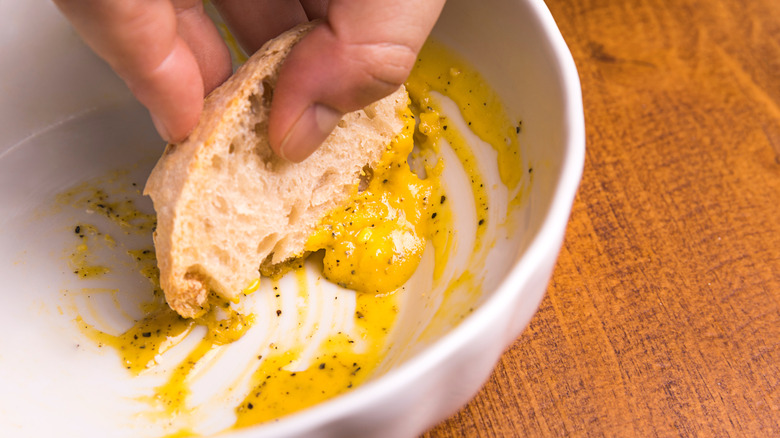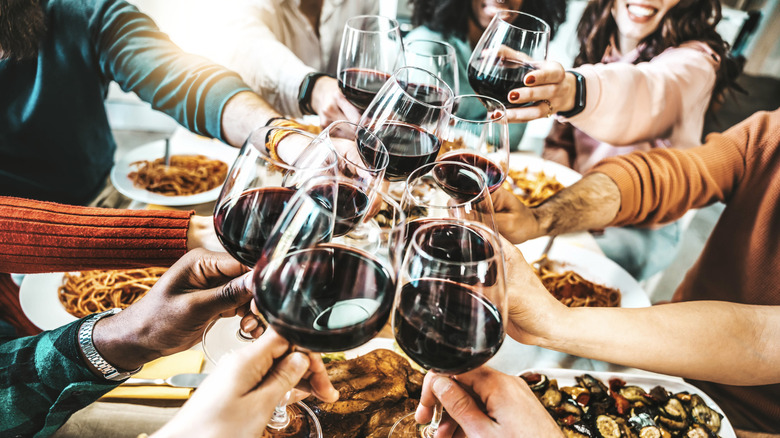This Delectable Bread Trick Doubles As A Good Etiquette Rule While Dining In Italy
Italy is one of the world's tourism hotspots for a reason. After all, this gorgeous European country seemingly has everything: art, beautiful architecture, incredible mountain views, beaches, charming country villages, and plenty of underrated destinations to choose from.
A visit to Italy is a blast to the senses, with alluring sights, sounds, aromas, and — best of all — tastes. Italy is world-famous for its amazing wine and mouth-watering cuisine, making a trip there worth it for the food alone. That said, there are some unwritten rules to follow when sitting down for a meal in Italy, which means tourists should educate themselves beforehand and think twice about ordering these things in restaurants.
A big part of Italian table etiquette concerns bread, which is eaten with almost every meal. So to avoid looking like a clueless tourist, don't expect popular bread additions like butter or olive oil. However, it is generally considered good form to mop up your plate with bread at the end of a meal. This not only guarantees that nothing goes to waste but also signals to the chef or host that you really enjoyed the food.
Use your bread as a utensil
Imagine you're sitting in a charming trattoria in the underrated city of Vincenza, indulging in a two-hour lunch. You've just finished a risotto with mushroom and peas, washed down with a glass of Vincenza Rosato, a locally-produced merlot and red blend. There is still plenty of bread on the table, and the remnants of the rich risotto sauce cover the bottom of your dish, making a very tempting target for a piece of bread.
Go ahead, sop up that sauce! Clean your dish and take down the saturated slice of bread as a final nod to the sheer deliciousness of it all. In Italy, this is called scarpetta and is a common way to finish your main dish in more informal dining settings. It signals to the chef that the food was so good that you could even eat more, which is about as high a compliment as you can offer.
Scarpetta is generally frowned upon in formal dining settings, but luckily there is a workaround. In situations when sopping up sauce with a handheld piece of bread may come across as too rough-mannered, you can always use your fork. With your utensil in hand, you can get down to the business of soaking up all of the remaining goodness. If you look around, you'll probably see that you aren't the only one.
Other Italian dining etiquette rules to know
Italians are very proud of their cuisine, which means they can be quite fussy about how it should be eaten. The most important thing to remember is that Italian food aims to highlight simple, natural flavors, so the overuse of condiments is frowned upon. This is especially true with fish and other seafood, which are never combined with cheese. It's simply not done in Italy, so think twice before reaching for the parmesan to sprinkle over your linguine with clams or scampi, unless you don't mind coming across like a barbarian in the locals' eyes.
Another simple dining etiquette rule the tourists frequently break is using a spoon to eat pasta, which may earn you disapproving looks. When you're at a restaurant, you'll be expected to order a bottle of water, so don't ask for tap water or worse, bring your own. To fit right in with the locals, hold your wine glass by the stem, not the bowl. Also, when it comes time to settle your tab, avoid asking to split the bill, as this is considered burdensome for the restaurant staff. Etiquette in Italy extends beyond the dinner table, so make sure you also know these 12 things tourists should never do while visiting.


